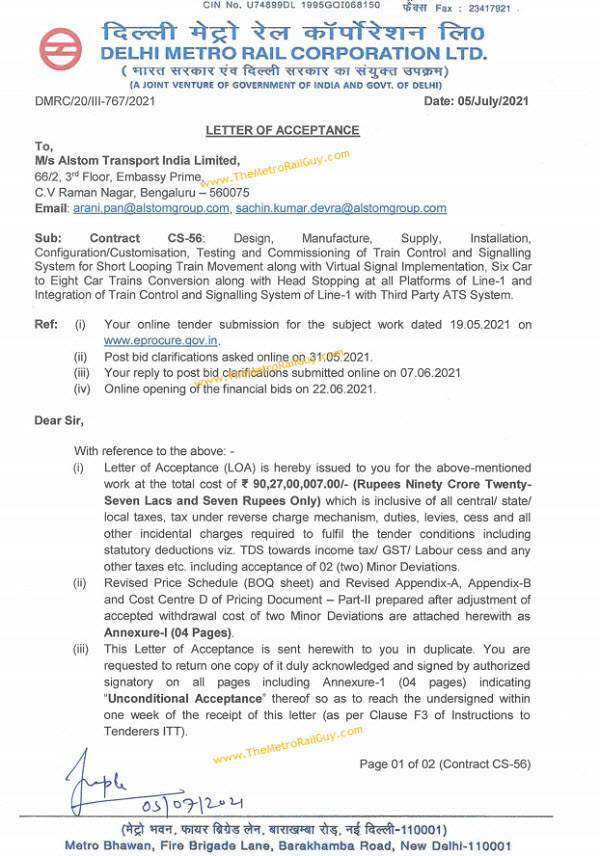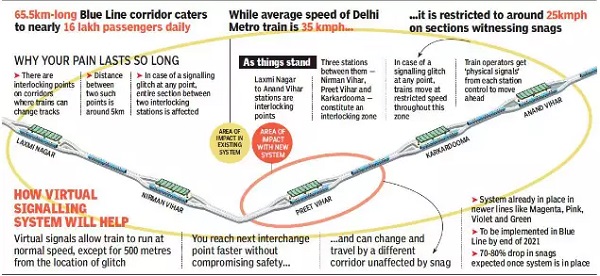Alstom Awarded Delhi Metro’s Signaling Contract for Red Line Upgrade
[ad_1]
Alstom Transport India on Monday was awarded a Rs. 90.27 crore contract to upgrade and introduce virtual signals on the Delhi Metro’s 34.4 km Red Line (Line-1) which connects Shaheed Sthal in Ghaziabad and Rithala.
This line with 29 stations, built between Phases 1-3, is equipped with Alstoms’ Urbalis-200 train-control & signaling solution. So when technical bids were opened in May, it was fairly obvious that Alstom was going to be one of the bidders, if not the only bidder for this contract.
As shared earlier – the signaling upgrade of the Delhi Metro’s oldest 3 lines (red, yellow and blue) has been in the works since at least 2019 by the Delhi Metro Rail Corporation (DMRC) with an aim to identify glitches and allow affected trains to still run at regular speeds of 33-37 kmph until the next interlocking section. The end goal is to provide smoother operations, prevent overcrowding at stations, and allow for short loop train services on congested segments.
DMRC had invited bids for the Red Line’s upgrade in March with an estimated cost of Rs. 90.27 crore and completion period of 15 months. Financial bids were opened on June 22.

Contract: CS56
Brief Scope: : Design, Manufacture, Supply, Installation, Configuration/customisation, Testing and Commissioning of Train Control and Signalling system for short looping train movement along with Virtual signal implementation, Six car to Eight car trains conversion along with Head stopping at all platforms of Line-1 and Integration of Train Control and Signalling system of Line-1 with Third Party ATS system
The installation, testing and commissioning of virtual signals is planned to be accomplished during non-revenue hours.
Here’s a grainy graphic from the TOI published in February 2020 related to the Blue Line where virtual signals are currently being installed. That line is equipped with Siemens’ signaling solution and is notorious for snags.

Excerpt from their article explaining virtual signals in further detail:
The Delhi Metro Blue Line corridor is divided between the ‘interlocking sections’. This is the portion between the metro stations where the trains can change the tracks. For example, both Laxmi Nagar and Anand Vihar stations are interlocking stations and the section on the route between them, comprising three stations, namely, Nirman Vihar, Preet Vihar and Karkardooma becomes one interlocking section. A signalling hitch at any of these interlocking sections disrupts the entire stretch. The movement is affected as the train operators need to acquire target speeds from each station manually. To ensure the safety of the passengers, the speed is restricted to 20-25 km per hour causing clumping of trains, leading to a cascading effect on the entire metro corridor.
The virtual signalling system is an intermediate entry and exit location displayed on the signalling monitor at the control centre. The system can be used to divide the routes between any two fixed signals. However, since it is not a physical signal, it only controls trains having automatic train protection. The concept of virtual signalling aims to keep the metro trains operating at the normal speed of 35-37 kmph. The virtual signalling system will also ensure that the trains reach the nearest interlocking section at a faster pace.
With this development, contracts for the oldest 3 lines’ upgrade have been awarded:
For more updates, check out the Delhi section or my Home Page!
– TMRG
[ad_2]
Source link
